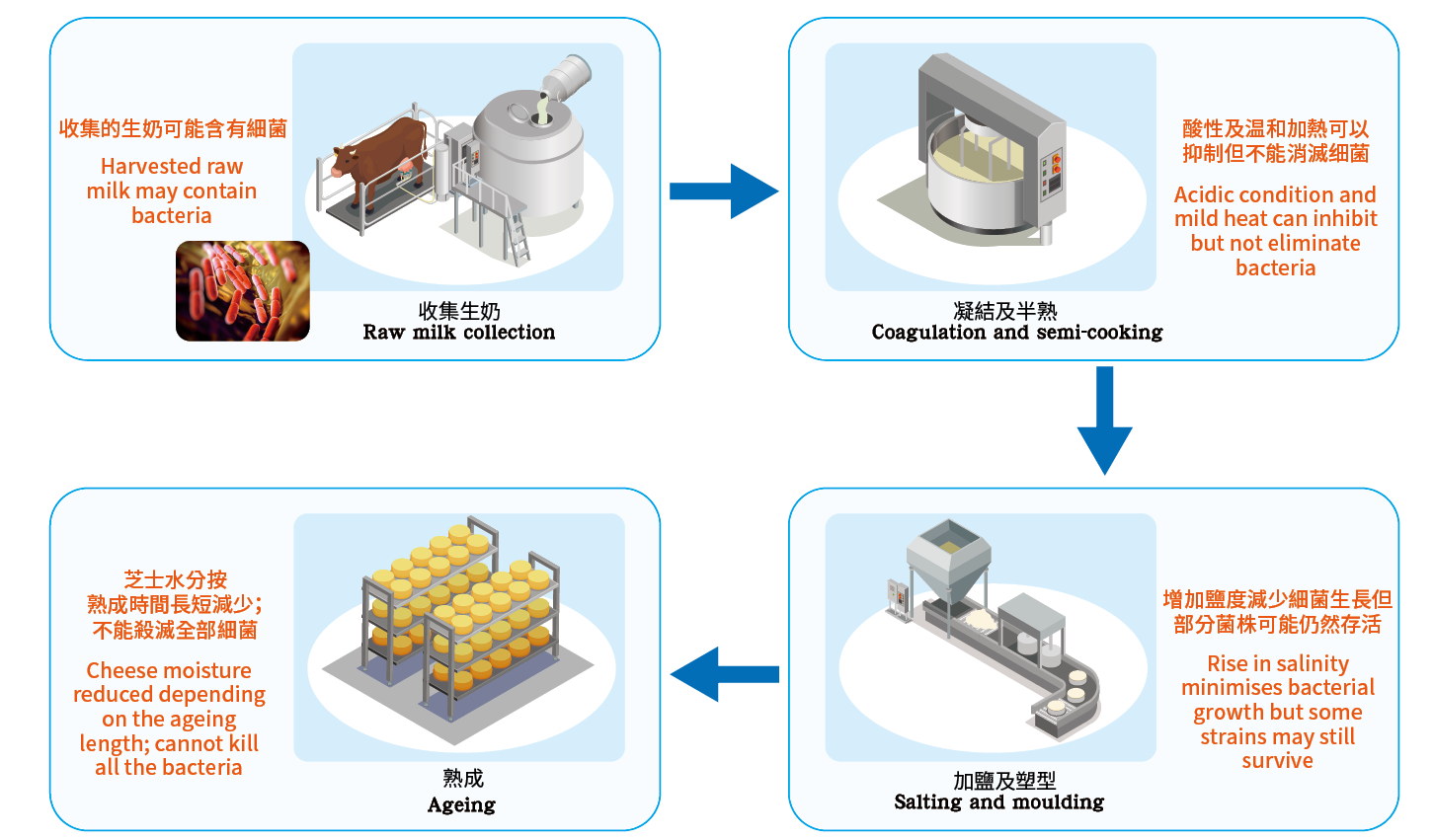
Food Safety Focus (173rd Issue, December 2020) – Incident in Focus
Shiga Toxin-producing Escherichia coli in Cheese made from Unpasteurised milk
Reported by Mr. Kenneth YIP, Scientific Officer,
Risk Assessment Section, Centre for Food Safety
In November 2020, the Centre for Food Safety (CFS) received notification from a food authority in Europe that a batch of Fontina cheese made from unpasteurised milk from Italy was being recalled due to possible contamination with Shiga toxin-producing Escherichia coli (STEC). The CFS then issued a food alert and prompted the importer to initiate a recall. This article explores how STEC threatens our health and how it gets into cheeses, and provides food safety advice on consuming cheeses and cheese products.

Figure 1: General cheese making steps
Health Concerns with STEC
E. coli are a large group of bacteria that can be found in the gut of healthy people. While most E. coli strains are harmless, STEC is a pathogenic strain that can cause severe foodborne illnesses. STEC has a low infectious dose and can survive at an ambient temperature from 7°C to 50°C. Some STEC can grow in acidic foods down to pH 4.4. STEC releases Shiga toxin which triggers cell death in the colon and causes damages to blood vessels, resulting in bloody diarrhoea. Besides, Shiga toxin can enter the bloodstream and cause severe illnesses such as haemolytic uraemic syndrome (HUS) and kidney failure. HUS is the most common cause of acute renal failure in young children.
According to the World Health Organization, STEC infection is a substantial public health issue worldwide and dairy products like cheeses are one of the food sources for STEC infection.
How STEC gets into Cheeses Made from Unpasteurised Milk?
Cheeses are generally produced from milk. STEC can be found in ruminants including cattle and goats which are natural reservoirs for the bacterium. Harvested milk may be subject to heat treatments such as pasteurisation, which eliminates pathogens, before being used for making cheese. However, certain kinds of cheeses are made from unpasteurised/raw milk to give the preferred flavours and aromas by some consumers. Cheeses made from unpasteurised milk are deemed as high-risk foods because pathogens may be present in the raw milk used.
In addition, fresh and soft cheeses made from unpasteurised milk are riskier than hard cheeses. Hard cheeses are usually subject to an ageing process in terms of months. Ageing depletes the cheese moisture content to produce a dry texture which can inhibit bacterial growth. Soft cheeses, on the other hand, have a shorter or even have not undergone any ageing process, which favours the growth of pathogens.
Tips for Consuming Cheeses Safely
The lack of sterilisation process during production implicates an inherent microbiological risk in consuming cheeses, particularly soft cheeses that are made from unpasteurised milk. Therefore, susceptible populations like pregnant women, infants and young children, the elderly and people with weakened immunity should refrain from consuming cheeses made from unpasteurised milk.
Key Points to Note
- STEC infection is an important public health issue worldwide and it can cause severe illnesses.
- Ruminants such as cattle and goats are natural reservoirs for STEC and unpasteurised milk from these animals my contain STEC.
- Cheeses made from unpasteurised milk are high-risk foods, and soft cheeses are riskier than hard cheeses as the water content of soft cheeses is not lowered to reduce pathogen load.
Advice to Public
- Be aware of the inherent risk in consumption of cheeses made from raw milk.
- Check the label and the type of cheeses (e.g. higher-risk cheeses like soft cheese, raw milk cheese, mould-ripen cheese) before purchase.
- Susceptible populations should avoid consuming cheeses made with unpasteurised milk.
Advice to the Trade
- Understand that cheeses made from raw milk are high-risk foods. Purchase cheeses and cheese products from reliable suppliers and keep proper records for efficient source-tracing.
- Provide customers with the information of the cheese, such as whether pasteurised milk or raw milk is used in the production, in order to make informed choices.
- List the high-risk food ingredients, cheeses made from unpasteurised milk for example, of dishes on menus and provide consumer advisory wherever appropriate.

